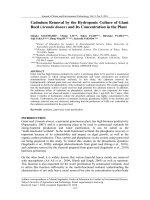THE MINE WATER POLLUTION THREAT TO WATER RESOURCES AND ITS REMEDIATION IN PRACTICE pdf
Bạn đang xem bản rút gọn của tài liệu. Xem và tải ngay bản đầy đủ của tài liệu tại đây (2.04 MB, 48 trang )
1
THE MINE WATER POLLUTION THREAT TO WATER RESOURCES AND ITS
REMEDIATION IN PRACTICE
PAUL L. YOUNGER
Pollution by mine drainage is a major problem in many parts of the world. The most frequent
contaminants are Fe, Mn, Al and SO
4
, with locally important contributions by other metals /
metalloids including (in order of decreasing frequency) Zn, Cu, As, Ni, Cd and Pb. Remedial
options for such polluted drainage include monitored natural attenuation, physical intervention to
minimise pollutant release, and active and passive water treatment technologies. Based on the
assessment of the key hydrological and geochemical attributes of mine water discharges, a rational
decision-making framework has now been developed for deciding which (or which combinations)
of these options to implement in a specific case. Five case studies illustrate the application of this
decision-making process in practice: Wheal Jane and South Crofty (Cornwall), Quaking Houses
(Co Durham), Hlobane Colliery (South Africa) and Milluni Tin Mine (Bolivia). In many cases,
particularly where the socio-environmental stakes are particularly high, the economic, political and
ecological issues will prove even more challenging than the technical difficulties involved in
implementing remedial interventions which will be robust in the long term. Hence truly 'holistic'
mine water remediation is a multi-dimensional business, involving teamwork by a range of
geoscientific, hydroecological and socio-economic specialists.
Hydrogeochemical Engineering Research and Outreach (HERO), School of Civil Engineering and
Geosciences, University of Newcastle, Newcastle Upon Tyne NE1 7RU, UK.
(E-mail )









